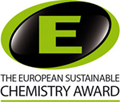The 10 most-accessed Green Chemistry articles between April and June 2013 were as follows:
Vegetables as biocatalysts in stereoselective hydrolysis of labile organic compounds
Björn Bohman, L. R. Cavonius and C. Rikard Unelius
Green Chem., 2009, 11, 1900-1905
DOI: 10.1039/B913936B, Paper
Hydrolysis of cellulose to glucose by solid acid catalysts
Yao-Bing Huang and Yao Fu
Green Chem., 2013, 15, 1095-1111
DOI: 10.1039/C3GC40136G, Tutorial Review
Deconstruction of lignocellulosic biomass with ionic liquids
Agnieszka Brandt, John Gräsvik, Jason P. Hallett and Tom Welton
Green Chem., 2013, 15, 550-583
DOI: 10.1039/C2GC36364J, Critical Review
FeIII–TAML-catalyzed green oxidative degradation of the azo dye Orange II by H2O2 and organic peroxides: products, toxicity, kinetics, and mechanisms
Naima Chahbane, Delia-Laura Popescu, Douglas A. Mitchell, Arani Chanda, Dieter Lenoir, Alexander D. Ryabov, Karl-Werner Schramm and Terrence J. Collins
Green Chem., 2007, 9, 49-57
DOI: 10.1039/B604990G, Paper
The role of flow in green chemistry and engineering
Stephen G. Newman and Klavs F. Jensen
Green Chem., 2013, 15, 1456-1472
DOI: 10.1039/C3GC40374B, Critical Review
Characterization and comparison of hydrophilic and hydrophobic room temperature ionic liquids incorporating the imidazolium cation
Jonathan G. Huddleston, Ann E. Visser, W. Matthew Reichert, Heather D. Willauer, Grant A. Broker and Robin D. Rogers
Green Chem., 2001, 3, 156-164
DOI: 10.1039/B103275P, Paper
Copper on chitosan: a recyclable heterogeneous catalyst for azide–alkyne cycloaddition reactions in water
R. B. Nasir Baig and Rajender S. Varma
Green Chem., 2013, 15, 1839-1843
DOI: 10.1039/C3GC40401C, Communication
A general and practical oxidation of alcohols to primary amides under metal-free conditions
Xiao-Feng Wu, Muhammad Sharif, Jian-Bo Feng, Helfried Neumann, Anahit Pews-Davtyan, Peter Langer and Matthias Beller
Green Chem., 2013, 15, 1956-1961
DOI: 10.1039/C3GC40668G, Paper
Development of GSK’s reagent guides – embedding sustainability into reagent selection
Joseph P. Adams, Catherine M. Alder, Ian Andrews, Ann M. Bullion, Matthew Campbell-Crawford, Michael G. Darcy, John D. Hayler, Richard K. Henderson, Catriona A. Oare, Israil Pendrak, Anikó M. Redman, Leanna E. Shuster, Helen F. Sneddon and Matthew D. Walker
Green Chem., 2013, 15, 1542-1549
DOI: 10.1039/C3GC40225H, Paper
Catalytic conversion of biomass to biofuels
David Martin Alonso, Jesse Q. Bond and James A. Dumesic
Green Chem., 2010, 12, 1493-1513
DOI: 10.1039/C004654J, Critical Review
Take a look at the articles and then let us know your thoughts and comments below.
Fancy submitting your own work to Green Chemistry? You can submit online today, or email us with your ideas and suggestions.






















